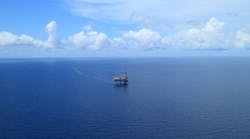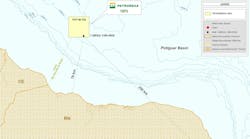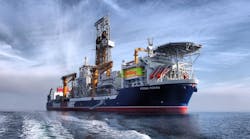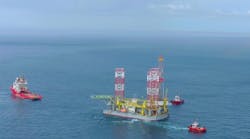Global applications for UKCS solutions
Jack Winton
KCA Drilling Ltd
Shell/Esso's Tern production platform uses multi-lateral wells to produce the marginal field.The success in the North Sea of multi-lateral well engineering in draining marginal reservoirs that would otherwise be uneconomic is not only extending the life of fields in the aging UK continental shelf, but it offers the possibility of global applications for this technology. Also, the process applied to the development of multi-laterals can be applied to any new technology in many environments.
Three areas of application have been identified where a multi-lateral approach can boost economics and reduce the risk and exposure associated with these types of wells:
- Technique can be applied by combining two marginal locations, such as the less prolific hydrocarbon bearing sands, in one slot, thus sharing the high costs of a new well when sidetrack candidates are not available. Apart from the savings made by combining the locations in one slot, the total uncertainty about the well's economics is reduced.
- A second application is the drilling of "premature" sidetracks from existing producers. This approach accelerates production. In theory, it does not increase the ultimate recovery, since the well could be drilled at a later stage, but if the field is only economic when tied in with other fields then this process may be necessary to ensure the field lives are consistent.
- Finally, the multi-lateral technique offers the opportunity to combine high uncertainty appraisal locations with lower risk development drilling. The reservoir would normally be developed in two stages. First, a proven area would be drilled, after which appraisal drilling would determine further scope for this reservoir. By combining the first development well with an appraisal leg and testing the extent of the accumulation, both oil production and important information can be accelerated. The value of this information is high in assessing the future of this accumulation. The effect this information has on production forecasting and economic end of field life is considerable.
- The pay zone that is achieved with two horizontal legs can be higher than with one, as there is a constraint on the finite length of a single horizontal section that can be achieved in one well.
- If uncertainty exists about the optimal direction for the horizontal leg (for instance in cases where separate sand bodies need to be encountered), a multi-lateral approach offers an extra degree of freedom, minimizing the risk associated with drilling the well.
Tern Alpha
Tern Alpha is a fixed installation in the East Shetland Basin of the Northern North Sea about 500 km from Aberdeen. Shell UK Exploration and Production (Shell Expro) operates the field on behalf of Shell and Esso, which are 50/50 partners. KCA Limited is the lead drilling contractor.First oil was seen in June 1989 and of the 30 slots available 10 have yet to be utilized. Tern forms one of five installations with associated subsea developments making up the Shell Expro Northern Business Unit (NBU).
Oil is produced from the Middle Jurassic deltaic sands of the Brent Group via the platform with gas lift and water injection facilities. STOIIP (oil in place) and recoverable reserves are currently estimated to be some 600 million bbl and 295 million bbl, respectively.
Production has been focused on the Etive, the most prolific reservoir sand in Tern. Etive production predominates in conventional wells, completed on all reservoir units. Consequently, the contribution from poorer quality formations has been marginal. With Etive development essentially complete, activity has shifted to multi-lateral technology as a cost-effective strategy for enhancing the productivity of the poorer quality Upper Ness and Rannoch formations.
This in-field strategy is coupled with a sustained focus on near facilities potential (NFP) opportunities, for example, the Triassic. The challenge for NFP is to quantify the value of potential hydrocarbon prospects quickly, thus enabling optimum incorporation into the field development plan.
Four multi-lateral wells have been constructed on Tern since late 1995. Each well has been designed to fit the required application but has utilized the same conceptual design theme. This design was originally based on standard oilfield technology applied using a novel approach. The four wells have evolved this initial concept using new technology, as it has become available.
The first multi-lateral well on Tern, TA-14, had a threefold objective.
- As an appraisal well to examine and test the undeveloped Triassic
- To develop the Rannoch and Upper Ness formations in the Brent sequence
- To use the (then new) multi-lateral well design to implement this.
Continued multilateral development of poorer quality Brent reservoirs.The pilot hole was drilled as an "S" shape well through the Jurassic and Triassic reservoirs to basement. Following the successful testing of the Triassic, the second and third objectives were met by drilling two cased hole horizontal laterals from the pilot hole. The success of TA-14 led to the confirmation of the drilling sequence for further applications of this technique.
TA-19 was originally planned as a sidetrack following water breakthrough. However, as a result of remedial work, net oil production increased and the decision was made to delay abandonment of the still commercial upper reservoir and sidetrack while retaining production capability from the main bore. Again, a horizontal lateral was drilled to develop the Brent and the well was subsequently completed as a cased hole dual lateral with co-mingled and selective production available.
The third multi-lateral well, TA-17, was designed to develop reserves proven in the TA-14 pilot hole and appraise the Triassic in an adjacent block. As a new well, it was possible to make use of a pre-cut window and latch coupling in the production casing. The main bore was drilled as a horizontal well intersecting as many of the uncemented Triassic channel sands as possible. The upper lateral was drilled from the pre-cut window as a horizontal appraisal well with a final inclination of 100 degrees, proving further reserves.
The recently completed fourth cased hole multi-lateral well, TA-06, was again a new well making use of a pre-cut window. This was a technological replica of TA-17 repeated on a similar application to TA-14, whereby the Rannoch and Upper Ness formations in the Brent sequence were developed. All four wells are currently producing. and in the drive to develop multi-lateral technology, lessons from its planning, implementation, evolution, and management have been generated.
Key learning points
KCA Drilling maintains an easily accessible lessons-learned database to ensure these lessons are recorded and mapped. This data is available to other asset teams within NBU to ensure there is a cross-fertilization of ideas and allow the current Tern team's successors access to the historical learning points. Steps are currently being taken to incorporate these and other learning points into an Internet-based learning database.The development of multi-laterals on Tern has generated a large number of highly specific learning points and details of these are contained within paper IADC/SPE 39353, available from the Society of Petroleum Engineers. The more generic learning points include:
- The project management team must have clearly defined roles and targets to ensure all areas of the planning stage and the operational stage are covered.
- The use of trials and dry runs ensures new techniques will work or will highlight potential failings.
- Detailed engineering drawings of downhole equipment and tools should be available offshore and onshore to ensure all parties are aware of exact depths.
- The transition joint liner lap into the production casing should span the lateral window with no couplings above the base of the window to allow efficient removal at a later date.
- Cementation of the lateral liner is critical for milling support during the transition joint liner lap removal and for subsequent junction integrity. Not only does the production casing and lateral liner cement provide isolation from the formation, the liner cementation provides stress support during the milling process.
- Whipstock design must include built-in contingency for recovery in the event the primary recovery method proves unsuccessful.
- Techniques should be employed to ensure a datum(s) can clearly be identified in the well at all stages of its life cycle.
- Debris management is critical, and where possible techniques to reduce the generation of debris should be used. It should be recognized that debris will always be created with these techniques and as such should be planned for and managed.
Conclusion
Benefits of the multi-lateral technique are pervasive. Savings on TA-14 and TA-06 type wells can be achieved by applying the technique in a combination of variable and low quality reservoirs in one single well. Slot constraints can be alleviated using the TA-19 technique by sidetracking existing producers at an earlier stage.This strongly accelerates production while safeguarding the often under-estimated tail production from the mother borehole. By using the TA-17 technique, appraisal and development objectives can be met from one borehole, which would have otherwise required two new wells.
The process applied to the development of multi-laterals on Tern can be applied to any new technology in many environments. This process will continue to be applied for future applications on Tern, such as water injection multi-lateral wells and coiled tubing drilling.
Reference
Winton, J. C., Lodder, R. J., Multi-Lateral Well Construction: A Multi-Benefit Drilling Technology, IADC/SPE 39353.Copyright 1999 Oil & Gas Journal. All Rights Reserved.






